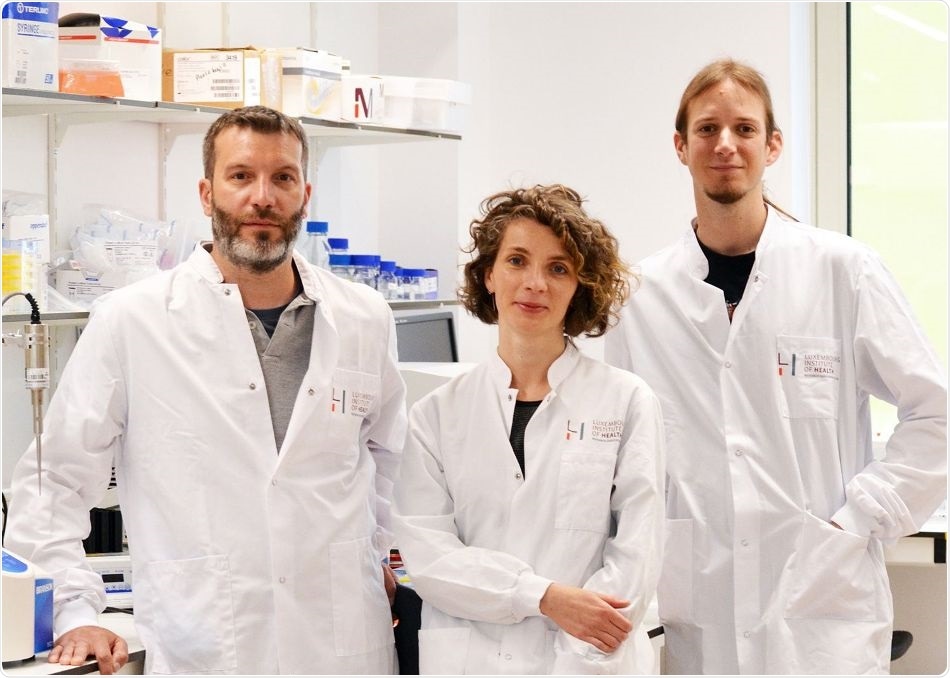A novel molecule LIH383 developed by scientists at the Department of Infection and Immunity of the Luxembourg Institute of Health (LIH) binds to and inhibits a formerly unknown opioid receptor in the brain.

From left to right: Dr Andy Chevigné, Dr Martyna Szpakowska, and Max Meyrath. Image Credit: Luxembourg Institute of Health.
This helps modulate the levels of opioid peptides created in the central nervous system (CNS) and potentiate their natural antidepressant and painkilling characteristics.
Opioid peptides are tiny proteins that serve as neuromodulators by communicating with four “classical” opioid receptors found on the surface of CNS cells. They play a major role in mediating pain relief and even emotions like anxiety, depression, euphoria, and stress.
Dr. Andy Chevigné, Head of Immuno-Pharmacology and Interactomics at LIH, and his research team developed the molecule based on their earlier research that had detected the atypical chemokine receptor ACKR3 as a new opioid receptor which adheres to natural opioids and “traps” them, thus reducing their antianxiety and analgesic activity.
These discoveries were published in Nature Communications—a leading international journal—on June 19th, 2020, and carry significant implications for developing a new class of drugs for depression, pain, and for treating brain cancer.
At present, opioid-related disorders like severe pain are mostly treated via drugs that work on the opioid system. Opioid prescription medications against pain—including fentanyl, oxycodone, and morphine—work by targeting and triggering opioid receptors, inhibiting the natural “pain message” from being transmitted, and modifying pain perception, thus leading to painkilling effects.
In spite of their effectiveness, the use of these painkillers often causes several side-effects, like dependence, respiratory disorders, and tolerance. Hence, new methods are urgently required to modulate the opioid system by employing drugs with new mechanisms of action and decreased complications, specifically considering the present public health crisis, called the “opioid crisis,” related to the growing addiction to and abuse of synthetic opioids.
In this aspect, the LIH researchers headed by Dr. Chevigné created and patented a new molecule called LIH383 that has the overall impact of boosting the availability of opioid peptides that adhere to standard opioid receptors in the brain.
LIH383 works specifically by targeting and inhibiting the atypical chemokine receptor called ACKR3, which the LIH team had demonstrated to be a novel opioid receptor with negative regulatory characteristics.
The researchers showed that the ACKR3 receptor contains a high affinity for a wide range of opioids, such as those belonging to the dynorphin, nociception, and enkephalin families.
But the communication between the ACKR3 receptor and these opioids does not produce the usual pain-relief or tranquilizing “messages” that occur when opioids couple to the supposed “classical” opioid receptors.
Interestingly, we found that ACKR3 does not trigger the distinctive chain of molecular signaling events that results in painkilling effects. Instead, ACKR3 functions as a ‘scavenger’ that sequestrates the opioids that would otherwise bind to the classical receptors.”
Max Meyrath, Study Co-First Author, Luxembourg Institute of Health
Meyrath continued, “In other words, ACKR3 is an atypical opioid receptor that traps the secreted opioid peptides and reduces the levels that can interact with traditional receptors, therefore mitigating their action and acting as a negative regulator of the opioid system.”
According to Dr. Martyna Szpakowska, the study’s co-first author, “Our findings essentially brought forward a new and previously unknown mechanism to fine-tune the opioid system and modulate the abundance of natural opioids by manipulating the fifth member of the opioid receptor family, ACKR3.”
Dr. Szpakowska continued, “We, therefore, set about developing a molecule that would be able to tightly bind to and block ACKR3, with the aim of potentiating the natural beneficial effects of opioids on pain and negative emotions. This is how LIH383 was conceived.”
The team then performed a proof of concept to test the efficacy of the LIH383 molecule in modulating ACKR3 activity and eventually filed a patent application in April 2020.
These outcomes pave the way for alternative options for treating anxiety, chronic pain, depression, stress, and even for cancer therapy.
Undoubtedly, apart from its recently described function as an opioid receptor, the ACKR3 receptor was initially called a chemokine receptor because it is also capable of binding to chemokines—small proteins released by immune cells which mediate immune reactions but which also have been demonstrated to be implicated in the initiation and metastasis of tumors.
In particular, the ACKR3 receptor is largely expressed in tumors like breast cancer and glioblastoma—which is known to be a highly aggressive type of brain cancer—and its presence corresponds to increased growth, metastasis, and resistance of tumors to chemotherapy and weak prognosis.
As an ACKR3 modulator that interacts and ‘interferes’ with ACKR3, LIH383 therefore also holds promise for the treatment of metastatic cancers, leveraging on our remarkable discovery of the dual chemokine-opioid ‘scavenging’ activity of this receptor.”
Dr Andy Chevigné, Head of Immuno-Pharmacology and Interactomics, Luxembourg Institute of Health
Chevigne added, “We expect LIH383 to act as a precursor for the development of a new class of drugs against pain and depression, thus offering an innovative and original therapeutic strategy to tackle the opioid crisis.”
This is a glaring example of the way fundamental research can be translated into concrete applications with tangible benefits for patients, leading to improved clinical outcomes.”
Markus Ollert, Study Co-Author, Professor, and Director, Department of Infection and Immunity, Luxembourg Institute of Health
“The success of our work was only made possible by the generous and unwavering support of the Luxembourg National Research Fund, the Ministry of Higher Education and Research, as well as the charitable initiative ‘Télévie’,” Professor Ollert concluded.
Source:
Journal reference:
Meyrath, M., et al. (2020) The atypical chemokine receptor ACKR3/CXCR7 is a broad-spectrum scavenger for opioid peptides. Nature Communications. doi.org/10.1038/s41467-020-16664-0.